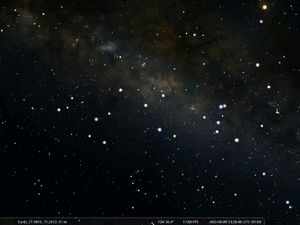Purva Ashadha: Difference between revisions
From All Skies Encyclopaedia
Purva Ashadha
No edit summary |
No edit summary |
||
| Line 18: | Line 18: | ||
===Transfer and Transformation of the Constellation=== |
===Transfer and Transformation of the Constellation=== |
||
<gallery> |
|||
File:Nakshatra temple magDraw lbl.jpg|Display of all 28th nakshatras in silver arch with candles in Tirupperunthurai (Athmanathaswamy temple) near Aranthangi, India, 10th century CE. (SMH 2025). |
|||
File:Nakshatras in Temple draw+lbl 4ase.jpg|Display of all 28th nakshatras in a door frame in Tirupperunthurai (Athmanathaswamy temple) near Aranthangi, India, 10th century CE. (SMH 2025). |
|||
File:20 PurvaAshadha draw.png| reconstructed by Jones (1720) |
|||
</gallery> |
|||
==Mythology== |
==Mythology== |
||
Revision as of 08:00, 31 October 2025
Purvaṣādha (पूर्व आषाढा) is an Indian name, used by the Indian Vedic tradition. Most of these names are roughly 3000 years old. They pre-date Hinduism but were taken over by it. Typically identified with δ and ε Sagittarii.
Etymology and History
Name Variants
- Purvaṣādha
- Purva Ashadha
- Jaladaivata,
- Jalarksha
- Apya,
- Toya,
Origin of Constellation
Ashadha means The Invincible and refers to two asterisms in Sagittarius. The First (Purva A.) is depicted as a group of two stars marking a horn or stinger. They are identified with δ and ε Sagittarii, the "arrow" of the Greek and Babylonian archer. The identification of δ is certain because of given coordinates in the 2nd millennium but instead of ε Sgr it could also be γ Sgr (at the tip of the arrow): the three stars form a racognizable pattern.
Transfer and Transformation of the Constellation
Mythology
mnemonic tales and cultural significance
Weblinks
References
- References (general)








